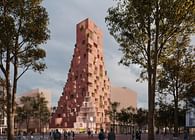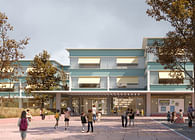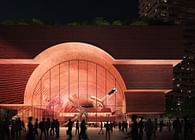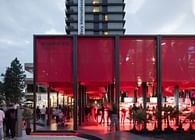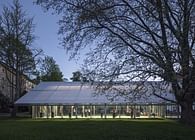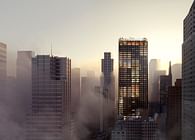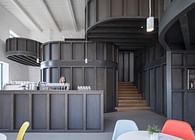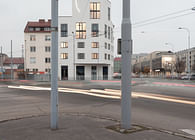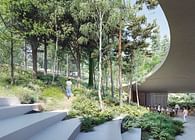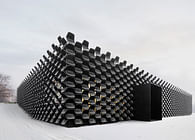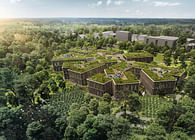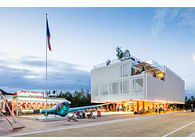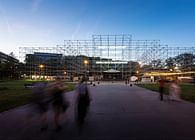
Brno, CZ | Bratislava, SK | Prague, CZ
Nestled in the Moravian countryside, the Lahofer Winery fuses the region’s longstanding wine tradition with a contemporary design in constant dialogue with the surrounding vines. Reflective of modern wine-making processes, the building brings together three distinct interconnected structures – a wine-making facility, the winery’s administrative base, and a visitor center and adjoining tasting room. Emulating archetypal wine cellars of the region, the vault of the winery rests on a grid of arched beams. Acting as a mirror of this shape, an undulant roof serves as an amphitheater for cultural events open to both locals and visitors, merging the
winery into the ground – and the culture – on which it rests.
Our project finds its roots in the legacy of the Lahofer Winery – one grounded in a
storied cultural heritage and a profound respect for the natural environment. Responding to Moravia’s topography and architectural tradition, rooted in the culture of wine, the architects conceive a design in symbiosis with the region’s landscape. Reminiscent of the region’s characteristic arched wine cellars, a
colonnade of vaulted beams frames the interior space into its storied curve. On its exterior side, draping the winery, an undulant roof acts as an inclined open-air amphitheater and cultural venue. Lightening the volume of the building as it rests on the fertile soil, below lie three separate spaces – each attributed with a distinct function, they share a constant concern for the adjoining nature.
Towered by the concave roof of the amphitheater, the space unfolds into a vast cellar, embracing the design of archetypal Czech wineries defined by the exposed rib construction of the arches. Each reinforced concrete arch is individually designed to fit a specific angle of the ceiling, while the distance between the arches is determined by that between the vine rows. Each module rises from a vine row
and runs through the space, achieving perfect visual symmetry and guiding the viewer’s gaze across the grapevines. Enclosed in a glass façade and facing south, the visitor center draws abundant light as the windows act as concealed separation from the exterior vine rows. Informed by the ambient nature, the visitor center invites visitors to fully experience its produce in the barrique cellar, made of wood, concrete and glass, and adjoining tasting room. A large-scale mural painting by Czech contemporary artist Patrik Hábl covers the entire ceiling area. Its tampered, irregular and sparse strokes, ranging from earthy reds and blacks to terroir-reminiscent browns and beiges, echo the variations of the soil and its weightlessness as it seemingly lifts from the ground, leaving its timeless markings on the walls.
In the continuity of this material wave, the structure houses its production in two halls of distinct heights, each mirroring a specific process. The first lower hall centralizes the operations, including wine-making production and employee facilities, while the second allows for operations that require lower temperatures, such as the wine press, the cellar, and the wine store. The varying heights of the interior spaces, emulating the terrain, allow for the alignment of corresponding functional exterior courtyards. While one courtyard serves as the operational area, centralizing logistic and production presses, the other holds the amphitheater, extending sweeping views of the landscape.
An open space emerging from the rhythmic vines, the amphitheater invests the boundless roof, overlooking a horizon nourished by its history. Expanding on the Lahofer Winery’s function from a production site into a witness to the local culture, it acts as a community space dedicated to cultural events, including local grape harvest celebrations and theater performances – a hub for its lasting
community to connect with visitors of the region and wide-ranging wine connoisseurs. The design of the Lahofer Winery is deeply rooted in nature, and in the respect thereof. At a time when culture and nature appear to be antagonistic forces, we envision a space reflective of the longstanding symbiosis between
the two in the region – one that profoundly respects the environment on which it rests. The structure unfolds into the native terrain, immerses itself into the surrounding vine rows, thereby preserving the essence and integrity of both soil and culture. Additionally, moving beyond a purely productive viewpoint, we prioritize the visitor experience, notably by allocating the roof as a public space open to local and international visitors – an experience essential to the understanding and appreciation of the wine.
Team: Ondrej Chybik, Michal Kristof, Adam Jung, Lenka Vorechovska, Hanin Al-Gibury, Karolina Holankova, Martin Holy, Vojtech Kouril, Ondrej Mundl, Matej Strba, Zuzana Zathurecka, Zuzana Pelikanova, Victor Cojocaru, Laura Emilija Druktenyte, Zuzana Lisonova, Gabriela Volakova
Status: Built
Location: Vinice 579 Dobšice, 671 82, Czechia
Firm Role: Architects
Additional Credits: Photography: alex shoots buildings, laurian ghinitoiu, pavel bartak
